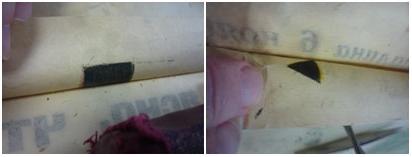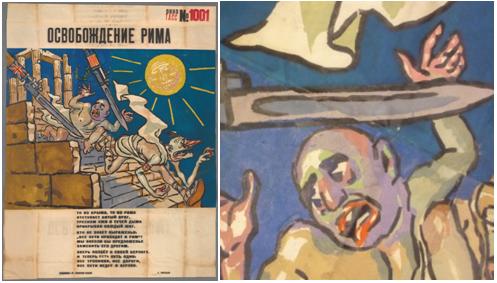
April 22, 2013, by Kathryn Steenson
Saving the Soviet War Posters
I have recently finished working to conserve eight Russian posters; these plus many more posters can now be seen on our Windows on War online resource.
The TASS posters were created during the difficult war years between 1943-45, although production ran from 1941 to 1946. They are known as TASS posters because they were produced by the TASS News Agency. These propaganda posters were created each day to raise morale and inform the population about the war effort. Most are very large posters, some standing 2 metres high or more and would have been displayed in and outside significant public buildings throughout the Soviet Union. They were never intended to stand the test of time – just one day in fact! Their ephemeral nature makes their survival all the more remarkable.
It has been interesting during conservation to take a closer look at the apparent method of the posters’ manufacture. They were made in sections on several sheets of thin (0.16mm), poor quality wood pulp paper (there was a war going on, so presumably such commodities were hard to come by!). The central images were designed by prominent Russian artists and poets, first into a sketch, then into a finished art piece (Windows on War has more details of the artists/poets involved). The artwork was then broken down into many different coloured stencils, as one would for a screen print. Once this was done a relatively unskilled team could apply gouache paint of the correct colour through each stencil before passing the poster on to the next stenciler, until all the colours had been added. In this way they produced sometimes as many as 1200 posters a day! I don’t know if the posters were manufactured in this people-intensive way because printing was simply not available or too costly, or because this was the fastest way to get them made.

Detail from the poster ‘Doughnuts and bumps’ showing the original location markers used by the stencilers (MS 281/1/8)
During my work on the posters I was excited to discover something that no one seems to have mentioned before. On many of the posters it is possible to find the original location markers that the stencilers used to line up the stencils correctly during production. These rectangular and triangular shapes would have been indispensable to the assembly of these complex posters. I thought it was also poignant to show some of the finger prints of the stencilers that are revealed in these hidden areas of the posters. Of course, these markers and finger prints are invisible from the front of the posters. The assembly line method and the difficulty they would have had to stencil and handle posters at their actual full size, almost certainly explains why the posters were created in smaller, more manageable pieces. These component parts were then trimmed and pasted together to form a whole image. Perhaps also worthy of mention is that the posters were then trimmed again after they had been assembled. This was done in rough way, with the resultant shape being anything but square.

Full image and detail from ‘The Liberation of Rome’ showing some of the complexity of the stencils/colours (MS 281/1/45)
Given the obviously difficult times that these posters were created in, it is even harder to explain why the posters were created to such high artistic standards! I don’t mean in terms of the “naive” look created by occasional misaligned stencilling mistakes or non-matching colours, these merely add to the charm of the poster image and explain something of the structure. But what is hard to explain is the sheer number of stencils and colours used to make up any one of these posters – in fact so many were used that it is difficult to work the number. It has been noted that upwards of 60 stencils were employed to create some of the more complex posters! This is a staggering number of colours and tones, and this may answer an earlier question, why not print them? It would certainly be rare for any print to have this number of screens, so in this respect, perhaps these posters were considered to be more subtle and superior in quality to what could have been produced by printing. When you think that these posters were designed to be viewed from a distance, this attention to detail wouldn’t have been strictly speaking necessary. So, if I had to guess, I would say they were just trying to do the best job they could with what they had available.
The story of how the posters came to be at the University of Nottingham is no less intriguing, and is dealt with in more detail in ‘The Story’ section on the website. What we do know from their condition was that the posters had been stored folded up into small bundles and kept that way for a long time. As the posters were opened out, it was possible to see clearly that at the exposed bundle edges, the poor quality paper has become discoloured (mid-brown) and the inevitable breakdown of the paper along these folds has led to multiple paper fractures. Even with the very limited handling the posters have undergone, these weak areas have split further, especially where the (sometimes thick) paint layer is sitting on the embrittled paper.
Another issue was that some sort of oil based ink has also been used on the text areas, and sometimes for the black areas within the central design itself too. There is some speculation that solvents (type unknown) were used to speed up the drying times of the poster inks. Looking at the posters there is certainly evidence to back up this theory, and it is clear that solvent has carried oil further into the paper substrate (these areas are particularly rigid and discoloured from the verso).
However, the lack of exposure of much of the paper and paint to atmospheric pollutants and light has meant that the colours are still remarkably vibrant, and on the whole the posters are intact!

Detail of ‘The Liberation of Rome’ showing the solvent tide line around one piece of text (MS 281/1/45)
The Conservation of the posters
I decided, in keeping with current principles on minimal intervention, that repair would be restricted to supporting these weak areas, and preventing further losses or tears opening up, whilst at the same time taking the opportunity to flatten out the creased and torn areas so that they were made as accessible for digitisation as possible. In the past, some of these posters have been digitised in their damaged state. So doing this conservation work now gave not only the best possible image, but also meant that the over-size posters were safer to handle throughout the digitisation process, and it is hoped that all the repairs will prevent further damage and loss occurring. I did consider a more interventive approach to the conservation treatment by fully lining and de-acidifying the posters. Lining would to some extent have covered over some of the important historical information on the verso of the documents, not to mention the incidental evidence of their manufacture (finger prints and location markers). De-acidification may still be considered at some time in the future, but wasn’t required to get the posters into a fit state for digitisation.
The paper was tested, and moisture didn’t appear to adversely affect the paper. However, I still decided that introducing more moisture than was strictly required to allow the paper to relax during the repair process was unnecessary. With this in mind repairs were carried out using a dry wheat starch paste and a strong light weight Japanese tissue. Another issue with the conservation of the posters is to do with their manufacture: they are made from separate sheets of paper, but little care was taken pasting and aligning them together, so they do not lie entirely flat. This was another reason why lining would have been difficult without separating the parts of each poster.

On a few occasions, lose material was re-inserted during the repair. This is a detail of MS 281/1/8 before, during and after repair.
Once conservation was completed the posters were digitised and then finally they were encapsulated in large polyester envelopes!
This guest post was written by Robert Pearce, Conservator at Manuscripts and Special Collections.
For information and updates, follow @windowsonwar or like us on Facebook.









Wonderful work from Mr.Pearce there.Having lived in Moscow myself for two years,I did happen to view some original source material from the TASS archives.It’s a credit to the restorer to have such excellent examples held within the UK also.